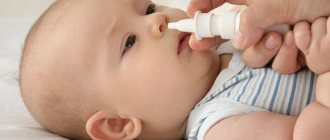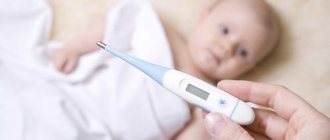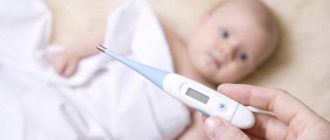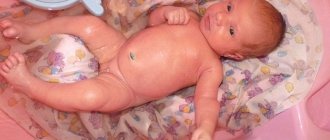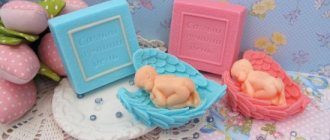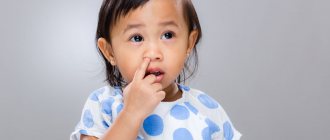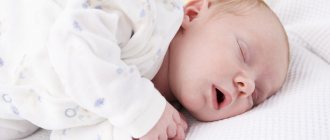Why do you clean a newborn's nose?
In the first few months of a baby's life, a procedure such as cleansing the nose is mandatory. This need is caused by the fact that the nasal passages of a newborn are very narrow, a lot of dust and mucus accumulate in them, which make breathing difficult and interfere with feeding and sleep. Even a tiny piece of lint from clothing can cause a toddler’s nose to become clogged. The baby does not know how to blow his nose, he is too weak and cannot cope with this problem on his own, so the help of his parents is necessary.
How to remove boogers from the nose of a newborn baby: reasons, how to clean them
Noticing that the baby is acting restless due to difficulty breathing, some mothers immediately pick up nasal drops. This situation is not always caused by a cold. The child’s sinuses may be clogged for another reason; the mother needs to solve the problem of how to get boogers out of a newborn’s nose using special means.
How to remove boogers
Causes of boogers in the nose
Many parents believe that if the baby’s nose is clogged, then the culprit is a runny nose. This is not entirely true. Mucus in small quantities should be present in the nasal sinuses so that the walls do not dry out (such an element of protection).
When you have a cold, a virus that gets into your nose causes snot to appear. They have nothing to do with ordinary goats. Although, when they dry out, they become similar to them.
Boogers have a completely different nature of formation; it is not always associated with a weakening of the baby’s immunity. The thing is that small hairs grow in a person’s nose, acting as a filter. The air that people breathe is not perfectly clean. To prevent micro-debris from entering the lungs when inhaling, vegetation in the nostrils is necessary in the form of bristles, which does not allow impurities to pass deeper.
What are boogers?
All the debris settles on the hairs, gradually clogging the nose. Children with developed motor skills are able to remove unpleasant congestion by picking their nostrils with their fingers. Newborns do not yet know how to do this.
The respiratory channels in the nose are too narrow in young children and therefore become clogged quickly. Various factors can lead to such trouble. They are identified by the boogers themselves, or rather by their shade:
- if the accumulations are dry and white, low indoor humidity is to blame;
- black - indicate that the baby inhaled dust, cigarette smoke, perfume mist, etc.;
- dried snot turns into yellow snot;
- green color indicates the presence of an infection in the respiratory tract.
Sometimes brownish veins can be seen in roe deer. These are traces of blood - blood vessels burst when sneezing (or for some other reason).
Why clean your spout?
Breathing disorders negatively affect the activity and calmness of the baby. A nose clogged with bugs prevents the child from eating and sleeping normally.
Why a newborn has a cold nose - reasons
When babies have difficulty breathing, they begin to intensively suck in air through their nostrils. This sometimes leads to complications - boogers can flow into the deep frontal maxillary sinuses or clog the lower respiratory tract.
Lack of hygiene of the nasal ducts in children can lead to increased intracranial pressure and seriously affect the decrease in the protective functions of the body.
Note! Infants with a constantly clogged nose experience a decrease in body weight, which leads to a lag in physical and mental development.
To avoid serious health problems, a mother should know how to clean boogers from her newborn baby’s nose. Even if the baby sneezes vigorously, he will not be able to independently reject the debris accumulated in his nose. Parents should clean it and carry out hygiene procedures regularly.
How to remove boogers from a newborn
How to suck snot out of a baby - how to remove it from the nose
An infant does not immediately learn to breathe through his mouth. Therefore, when the nose becomes clogged, the baby begins to feel anxious. One of the points in caring for your baby is sinus hygiene.
When it comes to newborns, a special approach is required. Cotton swabs are excluded immediately - the awkward movement of an inexperienced mother injures the little one's nose. Moreover, you cannot use a pin for these purposes.
There are safe devices for infants that can solve the problem of how to carefully remove boogers from a newborn.
Nasal Cleaning Devices
NameDescription
| Nasal aspirator* | The most recommended option, designed for children under 2 years of age. It is an improved model of a syringe, consisting of a storage tank and 2 tubes. The hygienic, quick cleaning procedure does not cause discomfort to the baby. |
| Pear | It is worth buying a device that is designed for use for newborns - it has a soft rubber tip that does not injure tissue. If you have a small enema at home, you can use it. |
| Flagella | You can’t call it a device – they simply make convenient tourniquets out of cotton pads for cleaning a newborn’s nose. |
*Battery-powered and vacuum-powered electronic aspirators can be found on sale. Their operating principle is similar to that of a vacuum cleaner.
Nasal aspirator
As an aid to help resolve the issue of how to clear dry bugs from a baby’s nose, the pharmacy may recommend special medications. They should not be used frequently so as not to disrupt the functioning of the mucous membranes and provoke allergies.
The same can be said about washing. In isolated cases it will provide effective assistance. Frequent use of solutions will cause irritation of the mucous membrane, swelling and lead to the development of chronic rhinitis.
How to clean a newborn's nose
Saline solution for rinsing a child's nose
You should not constantly pick a newborn's nose - this is dangerous for the mucous membranes. But you cannot allow the ducts to become completely clogged. Therefore, a visual inspection of the sinuses is carried out daily. Having noticed problems with breathing and finding unwanted accumulations in the nose, the mother immediately decides how to remove the roes from the newborn.
General points
Regardless of how the boogers are pulled out of the baby’s nose, they do it in compliance with the following recommendations:
- before removing dried suspensions, they must be softened with a washing solution or vegetable oil (olive, flax, sea buckthorn, sunflower) must be used;
- To soften boogers, you can use breast milk: instill it in each nostril or moisten a cotton swab, which is inserted into the nose for a few seconds;
Cotton flagellum
- Boiled potatoes will make the process easier: before cleaning the baby’s nose from boogers, warm mashed potatoes, “packed” in a bandage, are applied on top and held until the potato mixture cools down;
- the child may resist the unpleasant manipulation, so when removing the boogers, the little one’s head should be fixed with your hand.
Note! If the baby is restless, crying or sick, it is better to postpone the procedure. You can remove the piglets a little later, when the baby is in the mood.
How to use the devices
Before removing boogers from a baby, the mother should study the problem in theory. The health of the baby depends on how correct the further process is. Each of the devices described above requires its own approach.
Nasal aspirator
To remove the piglets from the ducts, one tube of the device is inserted into the baby’s nostril, and the adult takes the second one into the mouth and performs suction manipulations. The accumulations from the baby's nose migrate to the aspirator reservoir. The same actions are performed with the second nostril. Then the device is washed.
To make the procedure easier and more enjoyable for mom, it is recommended to use more advanced models instead of a mechanical aspirator:
- the vacuum device looks similar to a traditional aspirator, but works on the principle of a vacuum cleaner; the degree of suction of boogers can be adjusted;
- The electronic version is shaped more like a rubber bulb and is controlled by pressing a button.
All material removed from the sinuses after the procedure is immediately removed from the container, and it is disinfected according to the instructions supplied with the device.
Rubber bulb
Before removing the roe with a syringe, the air is released from it. This is achieved by squeezing the pear in your hand. Then the tip is inserted into the baby’s nose and the can is slowly released. After vacuum suction of the contents of one nostril, the pear is washed and switched to the second sinus.
Important! During the procedure, you should not make sudden movements so as not to damage the mucous membrane.
Flagella
This method is the safest option for getting a booger out of a baby’s nose. They make miniature turundas from cotton wool. You can use the disk by dividing it into several parts. Flagella corresponding to the size of the nostril passage are twisted.
A turunda moistened with water or oil is inserted into the nostril with a rotational movement and then slowly removed. You need to remove the baby dolls in this way until the baby’s nose is completely clean. At the same time, fresh turunda is used each time.
A cotton swab is convenient if you need to remove dry accumulations and crusts. If there is mucus, this method is useless.
Washing
If the mother does not know how to clean the newborn’s nose from dry boogers without causing him discomfort, it is recommended to rinse the nostril passages. To do this, use a regular pipette and a pharmaceutical saline solution of sodium chloride.
You can buy low concentration sea water designed specifically for newborns (“Aquamaris”, “Physiomer”, “Morenazal”, etc.). Place 2 drops of the composition into each hole, wait a few minutes and suction the goat with a bulb or aspirator.
How to wash a toddler's nose
The rinsing solution can be prepared at home. To do this, dissolve 1 tsp in one liter of warm water. table salt. The product is not only effective in removing boogers, but also has good disinfectant properties.
If you do not abuse this procedure, then cleaning your nose from dry crusts will give the following results:
- the roes in the nasal passages will soften and become more accessible;
- viscous, thick mucus, if any, will liquefy and be easily removed even from distant sinuses;
- the protective function of the nasal mucosa is normalized;
- The self-cleaning function is restored.
As a result, the child's breathing becomes free. The baby sleeps well, eats and is active during waking hours.
Aids
You can soften boogers in other ways alternative to washing:
- Vegetable oils (but not essential oils) moisturize crusts in the nose well; You need to lubricate your sinuses with this product carefully, using a small amount; otherwise, the hairs will lose their mobility and cease to perform the filtering function;
- ointments also have an enveloping property; if you use them, it is recommended to take those that have antimicrobial and anti-inflammatory effects;
- drops can be either medicinal (to combat rhinitis) or special - for cleaning and rinsing.
You should turn to auxiliary means if a lot of dry deposits have accumulated in the baby’s nose. They are not recommended for daily use.
You don’t have to remove the softened goats, but give them the opportunity to come out on their own. To do this, just tickle the baby's nose a little and provoke him to sneeze.
Prevention Tips
It is impossible to completely prevent the formation of goats (you cannot resist nature). It is quite possible to minimize the problem. By taking a number of preventative measures, the mother will not have to bother her baby with unpleasant procedures so often:
- It is necessary to regularly care for the cavity of the small nose, observing basic hygiene rules.
- To prevent the baby's mucous membranes from drying out, it is recommended to use air humidifiers indoors. If this is not possible, then you can get rid of the dryness in the room by hanging wet terry towels on working heating radiators. As an option, install containers of cold water in the room.
Air humidification in the nursery
- When a child develops white boogers, it is possible that the baby’s hydrobalance is disrupted due to low air humidity. Therefore, it is recommended to periodically give the baby water with honey (if there is no allergy to the bee product).
- Constantly ventilating the room not only increases humidity, but also prevents the development of fungal mold, the spores of which can get into the baby’s nose.
Note! Before opening the windows in the apartment, you need to make sure that smog, smoke from burning leaves, or car exhaust gases do not penetrate into the room from the street.
- If you carry out wet cleaning in the house every day, this will significantly reduce the amount of dust inhaled by your baby.
- Smoking is not allowed in the room where the baby is. You should not use aerosol perfumes, the “dust” of which settles in the child’s nose.
- A newborn should be protected from drafts and hypothermia, which can cause a runny nose.
- When going for a walk with your baby, it is recommended to lubricate the nose with nasal ointment. This will prevent infection from entering the respiratory tract.
Something to remember! Breasts cannot cope with the described problem on their own. All responsibility for the baby’s health and the microclimate in the house falls entirely on the adult family members. If a mother does not know how to remove a newborn’s piglet, she can turn to a pediatrician for help.
The doctor will give recommendations on choosing the appropriate method, tell you what solutions and how often to rinse the sinuses. In cases where hygiene is powerless against nasal congestion, the district police officer will refer you for a consultation with an ENT doctor in order to promptly identify (or exclude) a pathology in the child.
Source: https://kpoxa.info/uxod-razvitie/dostat-kozyavki-novorozhdennogo-iz-nosa.html
Causes of crust formation
The occurrence of dry boogers (crusts) in an infant is associated with its physiological characteristics. The mucous membrane of the nose constantly produces mucus, which is exposed to dust and other harmful substances from the outside. The air that small children inhale dries out these mucous secretions, resulting in the formation of crusts. Newborns do not know how to blow their nose and breathe through their mouths, so the occurrence of dry snot is inevitable.
The main reasons for the formation of crusts include:
- Colds, runny nose, which are accompanied by inflammatory processes of the nasal mucosa.
- The air in the room where the newborn is located is too dry.
You can reduce the appearance of crusts on your baby’s nose by following these tips:
- Control the air humidity (the optimal indicator is 50-60%) in the room where the baby is.
- Constantly ventilate your child's room, especially in winter, because at this time various heating devices are turned on, and the air in the room becomes hot and dry.
- Place several living plants on the windowsill in your baby’s room; they have a beneficial effect on the microclimate, moisturize and purify the air well.
- If possible, install a special device for humidifying the air in the room.
How to properly rinse a baby's nose
It is quite natural that all mothers are very kind to their newborn children, they reliably protect them and do not want them to get sick. But it happens, every day brings its own challenges. So, a stuffy nose in a baby can be a serious cause for concern. Therefore, it is useful for every mother to know how to rinse her baby’s nose. This is what our article is about today.
Nasal congestion in children can be a consequence of:
- viral infection;
- colds;
- allergies;
- foreign body entry;
- teething;
- dry indoor air, etc.
When the nose is clogged, the baby behaves differently than usual: his sleep and appetite worsen, he shudders in his sleep and is capricious. All this happens due to the fact that the child has difficulty breathing through the nose. The baby needs help. The most common cause of a clogged nose is a runny nose. To make breathing easier, you need to resort to rinsing your nose.
How to rinse a newborn's nose?
Newborn babies can have their nose rinsed if necessary. Of course, rinsing the nose makes it easier for the baby to breathe and improves his mood. But without an important reason, pediatricians do not recommend rinsing the nasal passages, since this procedure involves exposure to the mucous membranes of the nose, which are still very vulnerable in infants.
Rinse the nose with various means, for example, Aqualor, Aquamaris, Otrivin and even saline solution. Rinse your nose no more than 5 times a day.
Which nasal aspirator is better to choose:
How to properly rinse the nose of a baby with a runny nose:
- Clean your baby's nose. This can be done using a nasal aspirator or cotton wool. Excess mucus is removed using an aspirator or pear, and cotton wool flagella do an excellent job of removing crusts in the nose.
- Instillation of drops into the nose for rinsing. First, the baby is placed on his side. Using a pipette or other dispenser, you can drop 2 drops of the solution into each nasal cavity. You cannot pour a lot of liquid into the spout, because... the baby may choke. In addition, excess fluid can get into the baby's auditory tubes, which can lead to the development of otitis media in the baby.
- After 1-2 minutes, clean your nose again using an aspirator. The saline solution used for rinsing thins the mucus, making it easier to remove from the spout. Now the snot easily gets into the pear.
- You can dry your nose with cotton wool. You need to twist a thin cotton wool, insert it into the nasal passage and twist it slightly, gradually removing it from the nose. Do the same with the second nostril.
- The nose is now clear. If you have a runny nose, you can drip it with children's vasoconstrictor drops prescribed by the doctor for treatment. When the nose is washed and cleaned, vasoconstrictor drops work better than when the nose is full of mucus. This is why it is important to rinse your child's nose.
How to rinse a baby's nose?
Moms often ask what to use for rinsing the nose and how to rinse the nose correctly? You can rinse your baby’s nose with either special products purchased at the pharmacy or products prepared at home.
All solutions for instillation into a baby’s nose must be agreed upon with a doctor!
Saline solution
The famous doctor Komarovsky recommends rinsing the baby’s nose with saline solution. Ready-made saline solution is sold in pharmacies in the form of ampoules or bottles with a clear liquid. This product is safe for small children and is inexpensive. To rinse, pour 1 drop of saline into each nasal passage.
Aqua Maris
Made from purified sea water. Relieves inflammation of the mucous membranes of the nose and throat. It is important to note that Aquamaris spray can only be used by children over 1 year old. For children under one year of age, Aqua Maris moisturizing drops are sold, with which you can clean or rinse your nose with aquamaris.
Aqualor
Aqualor is adapted for children under one year old. Used for infectious diseases of the upper respiratory tract. The bottle with drops has a dispenser, which ensures gentle instillation. Aqualor can be used in children 2-4 times a day.
Otrivin
Otrivin nasal rinse solution facilitates the removal of mucus from the nasal passages. How many times can it be used? Use it 3-4 times a day before instilling vasoconstrictor drops.
Homemade saline solution
To prepare the solution, you need to take 1 teaspoon of sea salt and dissolve it in 1 liter of warm boiled water. This saline solution is weakly concentrated, so it is suitable for small children. Sea salt relieves inflammation, suppresses infection and thins mucus. Frequent use of saline solutions for infants is not recommended.
Herbal infusions
Some herbs have medicinal properties. Chamomile is famous for its anti-inflammatory effect, it suppresses the spread of infection. You can rinse your baby's nose with a weak chamomile decoction. The herbal mixture in the amount of 1 tablespoon is poured into 1 glass of water and brought to a boil. After half an hour, the broth is carefully filtered. To rinse a baby's nose, chamomile infusion is instilled 1 drop into each nostril.
Features of washing the nose in infancy
It should be noted that pediatricians do not recommend washing small children’s noses with sprays.
The fact is that sprays create a strong jet, which can damage the integrity of the nasal mucosa, and in addition, the saline liquid under strong pressure can enter the auditory tube. Fluid entering the middle ear will lead to the development of otitis media, which will worsen the situation. Thus, the term “nasal rinsing” in children under one year old means instilling a mole solution into the nasal passages, but not pouring or spraying.
Tips for mothers of babies to deal with nasal congestion
- The very first and most important rule: if your baby has a stuffy nose, consult a doctor. Don't rush into self-medication! Ask your doctor: how to wash a baby’s nose correctly?
- Once your baby is born, purchase a bulb aspirator to pull mucus out of your baby's nose. Children have not been able to blow their nose for several years; they need help.
- Before giving your baby vasoconstrictor drops prescribed by the doctor, take care to clean the nose, including by rinsing.
- Under no circumstances should you allow vegetable and other “medicinal” juices: aloe, onion, to get into your baby’s nasal cavity. Many people don't understand how dangerous this is. Even a harmless, at first glance, rinsing the nose with breast milk can lead to otitis media. This is the wrong way to wash.
- If your baby has a cold, give him breastfeeding more often to replenish fluids. This way the body will cope with the disease faster.
Let's sum it up
Little children are very vulnerable and helpless. Even a simple runny nose in a baby can cause concern. If your baby’s nose is clogged, you need to contact your pediatrician so that he can prescribe proper treatment. It is not necessary to rinse a newborn’s nose in all cases. This procedure is necessary only in cases where the baby has a cold, rhinitis or ARVI. To remove crusts from the spout, it is not necessary to resort to rinsing; they can be pulled out using cotton wool moistened with petroleum jelly.
grudnichokk.ru
How can you clean your baby's nose?
Cleansing manipulations of the respiratory tract are an unpleasant hygienic procedure for infants. He will turn his head and cry, and therefore you need to be extremely careful. Modern pediatricians, such as Dr. Komarovsky, do not recommend doing the following:
- Use your mouth to suck mucus out of your newborn's nose.
- Drip breast milk into the baby's nostrils, which can immediately develop microbes.
- Do not use cotton swabs or matches with cotton wool wrapped around them for cleaning; these devices can injure the baby’s nasal mucosa.
Before you start cleaning your newborn's nose, you need to prepare all the necessary items in advance. The choice of such devices for cleaning the respiratory tract depends on the degree of blockage of the nose, the age of the child, and the reason for the procedure (congestion, daily care). Let's look at the most common spout cleaning tools, their types and methods of use.
- Shopska salad - step-by-step recipes for cooking with feta cheese, Feta cheese or cottage cheese
- Rhinoplasty of the nose - medical indications for performing, aesthetic correction of shape and size
- Land tax benefits in 2020
Aspirator
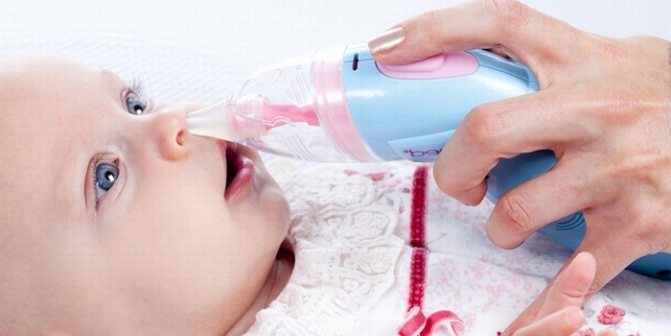
A special hygienic device for suctioning mucus in newborns, which does not cause discomfort, is called an aspirator. Before using this device, the spout is slightly moistened with a special solution. There are several types of aspirators:
- Mechanical. It is a small transparent container for snot with a straw and removable nozzles. One end of the tube is inserted into the newborn's nostril; through the second, the mother sucks in air and draws mucus from the nose into a special container.
- Electronic. This is a special battery-powered “pear” that, at the press of a button, pulls out snot. An electronic aspirator often has additional functions - humidification, aerosol.
- Vacuum. This device is used very rarely at home. In appearance, it resembles a mechanical aspirator, but it works by connecting to a special vacuum cleaner. It's inconvenient, noisy, cumbersome.
Aquamaris
To moisturize the mucous membrane of a newborn's nose and soften the crusts, use Aquamaris natural sea water. This drug can be used by infants under one year of age only in the form of drops; the spray is used for children over 1 year of age. Aquamaris drops contain many microelements and active substances, thanks to which the drug perfectly removes dust, takes care of the normal functioning of the nasal mucosa, and increases local immunity.
Syringe
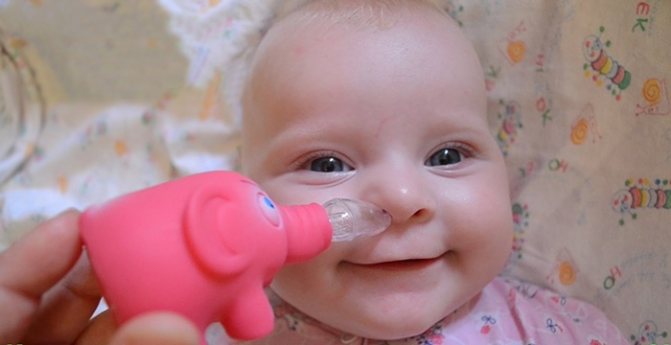
The easiest to use and most common aspirator is a syringe. In appearance, it resembles a regular “pear”, but has a special removable silicone tip. For newborns, small syringes with soft silicone nozzles are used. The principle of operation of the device is simple - you squeeze the syringe with your hand so that the air comes out of it, and then you need to insert the tip into the baby’s nostril, gently open the bulb and pump out the mucus.
- How to apply gel polish
- Fine for hogweed for summer residents
- How to renew your Kaspersky license
Pear
This is a traditional device that our mothers and grandmothers used. It was made of dense rubber and had a thin and soft tip. Using such a device is inconvenient and traumatic for a newborn. Modern pears have been improved:
- they have a wide tip that does not go too deep into the nostril;
- The tip of the device is removable, it can be easily unscrewed and washed;
- The material of the bulb is silicone, which is much stronger than rubber and leads to less mucus suction force.
Cotton flagella
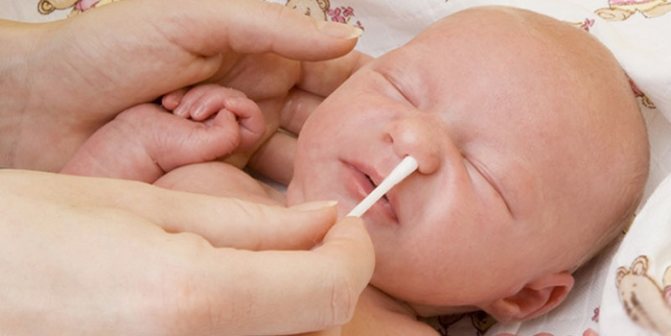
To remove small amounts of snot, crusts, and for daily hygiene procedures with a newborn, cotton pads are used. To make such a flagellum, you need to twist it from a piece of long cotton wool. Next, the device is lightly moistened with a special solution or sterile Vaseline and inserted into one nostril of the baby with slow rotational movements to a depth of 2 cm, then slowly and carefully removed. The procedure is repeated for the other nostril, but a new flagellum is used.
How to clean an older child's nose
A procedure figuratively called “ cuckoo ” is considered an effective way to cleanse the nasal passages for rhinitis and sinusitis. It can be done at home for children from about 5 years of age. To do this, you need a clean 5 ml syringe or a small teapot with a non-traumatic spout. Prepare a saline solution in advance: 2 grams of salt are dissolved in a glass of hot water, cooled and filtered. The child's head, standing over the sink, tilts toward the right shoulder. A warm salt solution or sea water is quickly poured into the left nostril with a syringe or from the spout of the teapot. At the same time, the child must pronounce the word “ku-ku”. Water will pour out along with mucus through the right nasal passage. Repeat this until your nose is clear. Next, the head is tilted towards the left shoulder, and the solution is injected into the right nostril.
You can purchase a Dolphin or Aqua Maris device at a pharmacy. This is a ready-made homemade “cuckoo”. Washing with them is prohibited if there is noise or pain in the ears.
At any age and with any runny nose , before instilling medicine into the nasal passages, they must be rinsed from accumulated mucus. This will help avoid complications of rhinitis and allow the drug to have its therapeutic effect.
Key questions: How to clean your nose? How to clean a newborn's nose? Aspirator for newborns? Washing with Dolphin.
Category: Children's diseases Topics: aspirator, dolphin, coklin, runny nose Link to material: How to clean a child’s nose with a runny nose. All ways to cleanse the nasal passages
How to properly clean a baby's nose
In order not to harm the newborn, during the hygienic procedure for cleaning the spout, it is important to follow these rules:
- If the baby is capricious or crying, postpone the procedure until he calms down.
- Wash your hands thoroughly with children's antibacterial soap and wipe them dry.
- Prepare in advance all the necessary equipment and means for cleaning the newborn’s nose.
- A comfortable temperature for babies in the room is 20-21 degrees.
- Ensure normal humidity in the room.
- Make sure there is no dust in the room.
- Never insert the device too deeply into your baby's nose.
- Dried crusts need to be softened before stretching.
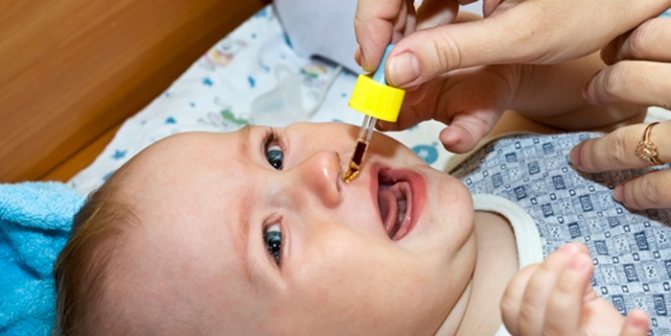
To make it easier for you to clean your baby’s nose, consider a detailed guide:
- The process of softening the crust and mucus. Apply drops of Aquamarine or saline solution to your newborn's nose. If you clean your nose in the evening, try giving your baby a warm bath, which will soften the mucus itself.
- Secure the baby's head. To do this, cover it with rolled up towels so that he cannot turn the head sharply.
- 2-3 minutes after instillation, clean the newborn’s nose with one of the following devices:
- Cotton tourniquet. Slowly insert the turunda into the nostril and twist it, then gently pull it out.
- Pear or syringe. Before cleaning the spout, pour boiling water over the device and wait until it cools down. Squeeze the bulb in your hands to release the air. Place the tip of the device on the baby's nasal passage and release the bulb clutched in your hands. Under pressure the mucus will come out. Then rinse the device and move on to the next nostril.
- Aspirator. Pour boiling water over all parts of the device and cool it. Place one part of the aspirator tube to the newborn's nostril, and draw air from the other side with your mouth.
How to rinse a newborn's nose
A runny nose in a newborn child requires close attention from parents, because babies do not yet know how to get rid of accumulated mucus in the nasopharynx on their own. First of all, you need to contact your pediatrician so that he can determine the cause of the disease and prescribe a treatment regimen. Usually, doctors first recommend rinsing the nose to facilitate nasal breathing and cleanse the mucous membrane of contaminants. In addition, this procedure increases the effectiveness of medications and prevents the occurrence of otitis media, bronchitis and other possible complications.
Causes of runny nose in infants
A runny nose appears in newborns for various reasons. The most common of them are colds and acute respiratory infections transmitted from sick relatives. But there is also a physiological runny nose: the formation of the baby’s nasopharyngeal mucosa ends, and it begins a kind of testing. This is manifested by copious clear discharge from the nose. Another reason is an allergic reaction to various irritants: dust, household chemicals, etc.
Recommended medications for each type of runny nose are different, so it is unacceptable to make a diagnosis without a doctor and self-medicate. But rinsing the nasal cavity is useful for any diagnosis, if there are no contraindications.
If this is not done, any drops and sprays may not reach the mucous membrane and may be removed along with the discharge. In addition, a newborn baby cannot always breathe normally through his mouth with a stuffy nose. There are known cases of infants dying from suffocation.
How to properly carry out the washing procedure?
Even such a relatively safe procedure should not be started without consulting a pediatrician. There are diseases in which rinsing the nasopharynx is contraindicated. They need to be identified in advance.
Before starting the procedure, you should prepare a washing solution, a syringe without a needle or a rubber syringe (a pipette will also work). It is not recommended to use an aspirator bulb, as the liquid can penetrate the Eustachian tube and cause otitis media. Some pharmaceutical drugs are already equipped with convenient dispensers and pipettes.
You can clean the spout with a regular cotton pad.
The sequence of actions is as follows:
- First, you should clear the child's nose of mucus using an aspirator or cotton pads.
- Next, you need to lay the baby on his side and drop a few drops of the solution into each nostril. The liquid should not get into the mouth or ears.
- To prevent the solution from leaking, tilt the child's head back. If the medicine gets into the nasopharynx, you need to turn the baby over on his tummy and pat him on the back.
- Place the baby in an upright position so that all excess flows out of the nose, wipe off the discharge with a handkerchief or napkin.
- Using an aspirator and cotton swabs soaked in oil (for example, Vaseline or apricot), clean the spout of mucus and residual solution.
A simple pipette is suitable for instilling the solution into the nose.
If the child already knows how to hold the head, you can rinse the nose in a vertical position over a basin. There is nothing complicated about this, but to avoid choking, you need to make sure that the baby's head is tilted forward and his mouth is slightly open.
Pharmacy preparations for rinsing
The easiest way is to buy ready-made medicine at a pharmacy. If you choose it according to the baby’s age, you can be sure that the composition is optimal and will not harm the child’s health.
We recommend reading: How to instill Aquamaris for newborns
Below is a list of the most popular pharmaceutical drugs:
- Saline solution is an inexpensive and effective remedy that does not dry out the nasopharyngeal mucosa and is not addictive. Can be used daily.
- Aquamaris is a preparation based on sea water. Effective for acute inflammation of the nasal cavity.
- Aqualor baby in the form of drops is designed specifically for infants. Helps with acute respiratory viral infections, infections of the nasal cavity, relieves swelling of the mucous membrane.
- Physiomer Unidose contains an additional set of microelements, quickly relieves swelling and makes breathing easier.
This is not a complete list of pharmaceutical solutions intended for newborns. It should be remembered that medicine for infants should be chosen only in the form of drops; sprays are strictly contraindicated before reaching the age of 1 year.
Homemade nasal rinse recipes
Now we often hear from mothers and grandmothers that the most effective remedy for a runny nose is putting breast milk in the baby’s nose. But modern medicine rejects this method, arguing that it promotes the proliferation of pathogenic bacteria and can cause complications. Even if breast milk accidentally gets into your nose, it is recommended to rinse it with saline.
Herbal infusions are a good home remedy for washing. They eliminate swelling, disinfect, and have anti-inflammatory properties. Herbs such as calendula, sage, and chamomile are most often taken as a basis. The solution should be weak: no more than 1 teaspoon of herb is used per 300 ml of water.
You can prepare saline solution at home. The recipe is very simple: dissolve 1 tsp. sea salt in 1 liter of boiled water. But such a solution will no longer be sterile. It is not recommended to add iodine or baking soda: there is a danger of drying out the mucous membrane.
Rinsing the nose is not a very pleasant procedure for both the baby and the mother, but it is difficult to overestimate its benefits. If you keep the mucous membrane in a clean and healthy condition from the very beginning of the disease, you can significantly shorten the recovery period and also avoid complications. And it will be easier for the baby himself, because free breathing through the nose is the key to good health.
mladeni.ru
How often should you clean your nose?
The frequency of cleaning the baby’s nose depends on its individual physiological characteristics and the degree of congestion of the organ with snot. For some babies, once a day is enough, for others – several times. Perform cleaning procedures in the following cases:
- If there are dry crusts in the respiratory tract.
- When mucus has accumulated in the baby's nose.
- When a newborn’s nose is clogged, he breathes heavily and his nose can be heard “grunting.”
- If the baby burps during feeding and particles of milk get into the nose.
How to properly clean a newborn baby's nose!
Newborn babies need constant care. The hygiene of the nasal mucous membranes requires special attention. Infants experience discomfort associated with a runny nose and congestion more severely than adults. Breathing disorders negatively affect the activity, feeding and sleep patterns of babies.
Constant whims make parents fearful and want to help. This must be done without harm to health or consequences. You can clean the nose of a newborn baby from dry boogers and snot with an aspirator, a cotton swab or a bulb at home.
These are the most popular and safest ways to regain the ability to breathe freely and feel good.
Why clean your child's nose when there is a runny nose or congestion?
The nasal canals in newborns are very narrow. They often become clogged, thereby complicating breathing.
Discomfort from a runny nose, accompanied by swelling and copious discharge, causes the child even more discomfort during wakefulness and sleep.
The baby does not yet understand that it is possible to switch to mouth breathing and is not able to blow his nose on his own. When sneezing, the nasal passages are cleared of mucus and foreign particles, but the protective reflex may not cope with large accumulations.
When children have a runny nose, they experience constant discomfort and are often capricious. Sniffing with their tiny nose, they, on the contrary, suck in secretions, and this can lead to complications. Otitis media, acute bronchitis, pneumonia and other diseases that are dangerous in infancy may develop.
A runny nose and nasal congestion in newborns provoke increased mucus production or swelling of the nasopharynx. Irritating symptoms are not always signs of colds and viral infections. The cause of many children's troubles can be low indoor humidity, dust accumulation, cigarette smoke, perfume aroma, etc.
It is enough to eliminate all negative influences and there will be no need to solve problems associated with nasal congestion.
This is good prevention, but if signs of difficulty breathing are already observed, and boogers and snot cause moodiness, poor sleep and appetite, it is necessary to clean the nose and help the baby get rid of discomfort.
Parents should take care of basic hygienic procedures for cleansing mucous membranes during a runny nose. In practice, cleaning a newborn’s nose from snot is not an easy task, especially when the young mother has no experience.
All available means are not suitable in this case, since infants require a special approach. Immediately eliminate cotton swabs. Any awkward movement can injure the baby's nose.
There are safer devices and procedures with which you can easily restore your breathing and solve the problem of congestion.
How to clean a newborn's nose, general recommendations
Cleaning the nose of a newborn baby from boogers and mucus is done only when necessary. There is no need to interfere with the narrow nasal passages and worry the baby. Inspect the nose and check your breathing several times a day. If you find anything unnecessary, remove it immediately. It is better not to allow accumulations, this will complicate the cleansing process.
There are a few more important recommendations:
- Before cleaning, mucus, boogers and crusts are softened with any rinsing agent.
- If the child is sick or restless, postpone the procedure.
- When cleaning, be sure to hold the baby's head with your hand. This is not a very pleasant manipulation for children. Be prepared for the fact that the newborn may be capricious and resist. This reaction should not stop, since accumulated snot and dry boogers can aggravate the situation and harm your health.
A variety of devices help free the nose and return free breathing to the newborn baby. Most often, mothers use special aspirators, a syringe (bulb), and cotton wool. You can try each of the devices and choose the one that is more convenient for you.
Nasal aspirator for cleaning
Cleansing with an aspirator is considered the most effective way. The device is designed specifically for both newborns and children under 2 years of age. It makes it possible to carry out the procedure quickly and hygienically. During cleaning, the baby does not experience discomfort; the sensation is very similar to a slight tickling.
An aspirator is an improved syringe. The mechanical device consists of a container and two tubes. One is inserted into the baby’s nostril, the mother takes the other into her mouth and makes suction movements. All contents are easily and quickly removed into the container. If one procedure is not enough, you can repeat it several times. The main thing is to do everything correctly and carefully.
You can use electronic aspirators equipped with batteries, or vacuum ones that operate on the principle of a vacuum cleaner.
Freeing the nose using flagella
You can clean the nose of newborn children with a cotton swab. Homemade flagella are considered the safest option for clearing the nasal passages. You can make them from a cotton pad. Divide it into several parts and twist a miniature turunda corresponding to the size of the nostril passage.
Thin, dense flagella are inserted into the nostril with rotational movements and the contents are slowly extracted. This method helps to quickly remove crusts, but cotton wool may not be able to cope with the abundance of accumulated mucus.
Removing excess with a pear
You can buy a pear at a pharmacy. For newborns, such devices are made with a soft rubber tip. If you cannot find one, a small enema will help you.
Before insertion into the nostril, the balloon is squeezed by hand. This is necessary to ensure that all the air comes out. After inserting the tip into the newborn's nose, slowly open the syringe.
Under the influence of vacuum, everything unnecessary is drawn in. Remaining mucus can be removed with a cotton pad. The pear procedure is done without sudden movements, but excessive slowness can interfere with cleansing.
Such intervention simply will not have any effect.
If there is too much mucus or thick, opaque discharge, consult a doctor. Such a runny nose can signal the development of a serious illness.
Nasal cleaning aids
To treat a runny nose in newborns and clear the nose of mucous secretions, it is better not to resort to medications unnecessarily. Even drugs approved for infants disrupt the functioning of the mucous membranes, cause addiction, allergies and other unpleasant consequences. To avoid overdrying, the nasal passages must be periodically washed and treated with special compounds.
Pharmaceutical saline solutions are very popular among treatment products. Two drops of moisturizing liquid are simply pipetted into the newborn's nose. Such procedures moisturize the mucous membrane and prevent infections from entering the nasopharynx.
You can make the solution yourself. The recipe is simple: dissolve table salt (1 tsp) in warm water (1 liter). The composition of homemade saline solutions is identical to pharmacy ones and is no less effective. They have a disinfecting and drying effect, which is very useful for a runny nose.
Do not overuse rinses. With frequent use of solutions, the mucous membrane becomes irritated and begins to swell. This can lead to chronic rhinitis in a newborn.
Often in newborn babies, after heavy mucous discharge, redness appears near the nostrils. You can lubricate them with special baby ointment and oils. Consider the possibility of allergic reactions. If in doubt, consult your pediatrician.
Use a humidifier if possible. In unventilated rooms with dry air, infants experience discomfort and often get sick. It is very important to monitor the atmosphere of the room and maintain a comfortable microclimate.
Conclusion
Proper care of newborns and proper hygiene can avoid many health problems. Regardless of the causes of a runny nose, if young children have difficulty breathing, they need to clean their nose.
Newborns are helpless and unable to cope with the problem on their own, so all responsibility falls on the parents. At home, you can clean your nasal passages with special devices and antimicrobial solutions.
If you do not have experience and knowledge, go to a doctor and consult about the safety and acceptability of cleaning methods.
I also recommend reading my new article - Can a child go to the bathhouse when he coughs?
From the author
I am glad that you read this article to the end. I can assume that you liked it, and the absence of advertising, which constantly distracts you from reading, created comfortable conditions for your pastime on my channel.
Give it a “ Like”
” if the article has satisfied your interest. Your rating will help me write more interesting material.
I will be grateful if you subscribe to my channel by following this
link or clicking the “ Subscribe ” button under this article.
I promise to please you only with high-quality content! I will be glad to see you again on my channel.
Source: https://zen.yandex.ru/media/id/5a1512963dceb7d520ee12b3/5a6ca4a277d0e621d1cfdd9b


